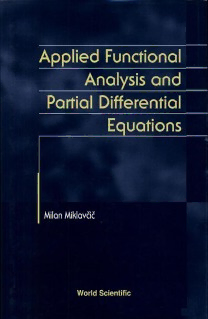
Applied Functional Analysis and Partial Differential Equations PDF
Preview Applied Functional Analysis and Partial Differential Equations
APPlIed Functional Analysis and Partial Differential Equations 1 Milan World Scientific Applied Functional Analysis and Partial Differential Equations Applied Functional Analysis and Partial Differential Equations Milan Miklav& Michigan State Universily ' World Scientific ih Singapore • NewJersey• London .Hong Kong Published by World Scientific Publishing Co. Pte. Ltd. P 0 Box 128, Farrer Road, Singapore 912805 USA office: Suite 1B, 1060 Main Street, River Edge, NJ 07661 UK office: 57 Shelton Street, Covent Garden, London WC2H 9H1E British Library Cataloguing-in-Publication Data A catalogue record for this book is available from the British Library. First published 1998 Reprinted 2001 APPLIED FUNCTIONAL ANALYSIS AND PARTIAL DIFFERENTIAL EQUATIONS Copyright © 1998 by World Scientific Publishing Co. Pte. Ltd. All rights reserved. This book; or parts thereof, may not be reproduced in any form or by any means, electronic or mechanical, including photocopying, recording or any information storage and retrieval system now known or to be invented, without written permission from the Publisher. For photocopying of material in this volume, please pay a copying fee through the Copyright Clearance Center, Inc., 222 Rosewood Drive, Danvers, MA 01923, USA. In this case permission to photocopy is not required from the publisher. ISBN 981-02-3535-6 Printed in Singapore by Uto-Print Contents Preface Linear Operators in Banach Spaces 1 1 1.1 Metric Spaces 1 1.2 Vector Spaces 6 1.3 Banach Spaces 8 1.4 Linear Operators 11 1.5 Duals 16 1.6 Spectrum 23 1.7 Compact Linear Operators 29 1.8 Boundary Value Problems for Linear ODEs 39 1.9 Exercises 43 2 Linear Operators in Hubert Spaces 47 2.1 Orthonormal Sets 47 2.2 Adjoints 54 2.3 Accretive Operators 58 2.4 Weak Solutions 62 2.5 Example: Constant Coefficient PDEs 68 2.6 Self-adjoint Operators 70 2.7 Example: Sturm-Liouville Problem 76 2.8 Sectorial Forms 80 2.9 Example: Harmonic Oscillator and Hermite Functions 88 2.10 Example: Completeness of Bessel Functions 92 2.11 Example: Finite Element Method 96 2.12 Friedrichs Extension 99 2.13 Exercises 104 3 Sobolev Spaces 109 3.1 Introduction 109 3.2 Fourier Transform 114 3.3 Distributions 122 V 3.4 Weak Derivatives 126 3.5 Definition and Basic Properties of Sobolev Spaces. 135 3.6 Imbeddings of 140 3.7 Elliptic Problems 153 3.8 Regularity of Weak Solutions 160 3.9 Exercises 163 4 Semigroups of Linear Operators 167 4.1 Introduction 167 4.2 Bochner Integral 171 4.3 Basic Properties of Semigroups 176 4.4 Example: Wave Equation 187 4.5 Sectorial Operators and Analytic Semigroups 192 4.6 Invariant Subspaces 204 4.7 The Inhomogeneous Problem -Part I 209 4.8 Exercises 212 5 Weakly Nonlinear Evolution Equations 215 5.1 Introduction 215 5.2 Basic Theory 218 5.3 Example: Nonlinear Heat Equation 222 5.4 Approximation for Evolution Equations 224 5.5 Example: Finite Difference Method 233 5.6 Example: Galerkin Method for Parabolic Equations 236 5.7 Example: Galerkin Method for the Wave Equation 239 5.8 Friedrichs Extension and Galerkin Approximations 243 5.9 Exercises 245 6 Semilinear Parabolic Equations 247 6.1 Fractional Powers of Operators 247 6.2 The Inhomogeneous Problem - Part II 254 6.3 Global Version 257 6.4 Main Results 259 6.5 Example: Navier-Stokes Equations 267 6.6 Example: A Stability Problem 271 6.7 Example: A Classical Solution 273 6.8 Dynamical Systems 276 6.9 Example: The Chafee-Infante Problem . 279 6.10 Exercises 282 vi' Bibliography 285 List of Symbols 289 Index 291 Preface This book is an introduction to partial differential equations (PDEs) and the relevant functional analysis tools which PDEs require. This material is intended for second year graduate students of mathematics and is based on a course taught at Michigan State University for a number of years. The purpose of the course, and of the book, is to give students a rapid and solid research-oriented foundation in areas of PDEs, like semilinear parabolic equations, that include studies of the stability of fluid flows and, more generally, of the dynamics generated by dissipative systems, numerical PDEs, elliptic and hyperbolic PDEs, and quantum mechanics. In other words, the book gives a complete introduction to and also covers significant portions of the material presented in such classics as Partial Differential Equations by Avner Friedman, Ge- ometric Theory of Semilinear Parabolic Equations by Dan Henry, and Semigroups of Linear Operators and Applications to PDEs by A. Pazy. The need for such a book is due to the fact that in order to study PDEs one needs to know some functional analysis, which requires a thorough knowledge of real analysis (Lebesgue integral). Therefore, if real analysis is studied in the first year of graduate school, and functional analysis in the second year, the student only begins with PDEs in the third year - and may even have to re-learn functional analysis if the prior instructor ignored unbounded operators (which sometimes happens). The reader is expected to be comfortable with the Lebesgue integral; more specif- ically, with the material presented in Examples 1.3.4 and 1.5.2. The Cauchy Theorem is also used in a couple of places, with the most difficult version used in (4.44). These are the only real prerequisites for the whole book. Above this level, all theorems used are proved in the text. One may, and perhaps should, skip over some of the proofs. However, they are included in case they are needed. With regard to the writing style, all formal statements, like Theorems, contain all assumptions except for those declared at the beginning of the section in which the statement appears. This should make it easy, even for a casual reader, to figure out what is actually assumed in a given statement. There is, however, one exception. Throughout Chapter 3 it is assumed, unless otherwise specified, that Q is an arbitrary nonempty open set in n E N. In the first two chapters functional analysis tools are developed and differential operators are studied as examples. Sturm-Liouville operators are nice examples of self- ix
